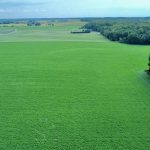A team of Winnipeg researchers has found a faster, easier and cheaper way to test for fusarium headblight.
The fungus has plagued Manitoba, reducing farmers’ yields and returns. Recently, it has appeared in Saskatchewan fields.
Fusarium can produce deoxynivalenol, known as DON, which can put livestock off their feed. Maltsters also reject barley with detectable levels of vomitoxin.
Existing tests for the fungus and the toxin are more expensive and slower than the new test, said Ron Marquardt, an animal scientist at the University of Manitoba.
Read Also

Forecast leans toward cooling trend
July saw below average temperatures, August came in with near to slightly above average temperatures and September built on this warming trend with well above average temperatures for the month.
The new test is similar to a rapid-response pregnancy test. A farmer or grain buyer could use a dipstick in a grain and water solution to determine whether there are fungi in the grain.
Researchers are looking for an industry partner to commercialize the test, said Dave Abramson, a scientist who helped develop it at Agriculture Canada’s Cereal Research Centre.
Cost benefit
The test comes as welcome news to Randy Clear, a mycologist at the Canadian Grain Commission who tests grain for fusarium.
“It would save me a lot of time, and of course, time is money,” said Clear.
It takes about five days to detect whether a grain sample is infected with fusarium using traditional methods. Trained technicians sterilize the kernels, place them on agar, a jelly-like substance, and grow a fungus in order to identify it.
To accurately estimate the level of infection in a sample, technicians should examine at least 100 kernels. All told, the test costs about $60, Clear said.
The new test yields objective data within several hours, said Abramson.
“You could set up a small operation in limited space and you really would not need expensive laboratory set-up or highly trained people,” he said.
While the test could be used to estimate approximate levels of the DON toxin, it would not replace more precise methods.
“If you want to have a more precise answer, then you need to do the longer test, which is usually done in the laboratory,” said Marquardt.
The new test could cost about $10, while a lab test using similar technology to detect the level of DON costs about $40. An even more precise method costs about $400.
The new test will help plant breeders tell the difference between susceptible and resistant varieties, said Abramson.
The test could also be used by regulatory agencies and grain buyers who need to know for food and feed safety reasons whether a load of grain is infected with fusarium.
Clear said he thinks the test may be particularly useful for barley. While tombstone kernels in wheat are a good visual indicator of fusarium, the fungus in barley is not always visible to the naked eye.
Malting companies look for toxins when they’re selecting barley for malt, and most only accept barley with no detectable level of vomitoxin.
“There would be thousands and thousands and thousands of dollars going into that type of testing for the toxins in Canada,” he said.
By knowing whether the fungus was present, they would know whether to continue testing.
Clear said plant pathologists could also use the test to track the spread of fusarium.














